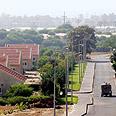
High growth rate in settlements. Ganei Tal settlement (before evacuation)
צילום: איי פי
Rise in settlement population
Central Bureau of Statistics publishes data on Israeli population according to regions; settlement population rises by 4.3 percent since September 2004
Updated data published by the Central Bureau of Statistics show that the growth rate of the settlements' population is particularly high.
The number of people living in settlements has increased by 4.3 percent since September 2004 to 243,100 people. However, the data regarding the settlements still include the residents of the evacuated areas.
In two of Israel's big cities, the future does not look so bright: Thousands continue to immigrate from Jerusalem and Haifa, while in Tel Aviv the population growth rate continues to increase.
A growth in the number of residents has also been noted in Israel's kibbutzim and moshavim, due to new constructions.
At the end of September 2005, the Israeli population amounted to 6,956,699 people. During the first nine months of the year, there was an addition of approximately 87,100 people.
Tel Aviv-Jaffa received 5,200 new residents
The major part of the increment, approximately 77 percent, constitutes natural increase, while the rest is a result of the international immigration balance (difference between the number of immigrants and the number of Israelis who left the country for more than one year).
The expected growth rate for 2005 is 1.7 percent, which is lower than the growth rates noted in 2003 and 2004 (1.8 percent) and in 2002 – 1.9 percent. It seems that the deceleration is as a result of the decrease in the number of births and in the number of new immigrants.
In Jerusalem, Israel's most populated city, the population grew at a higher than average rate – 1.8 percent, to 716,000 residents. However, the internal immigration balance continued to be negative (-4,470 people).
In Haifa, Israel's third most populated city, the drop in the number of residents continued, and the total growth rate was negative. The number of Haifa residents at the end of September 2005 amounted to 267,800 people, and the city also suffered from a negative internal immigration balance (-1,800 people).
Tel Aviv-Jaffa received 5,200 new residents, about half of them through internal immigration. The number of Tel Aviv-Jaffa residents at the end of September 2005 amounted to 376,000 people, with an annual growth rate of 1.9%.
The population living in moshavim and collective moshavim amounted at the end of September 2005 to 232,100 people, and it constitutes the largest rural form of settlement. The population growth rate surpassed the national average – 2.6 percent, but was lower than the previous year's growth rate.
The kibbutzim's population amounted to 117,200 people and its growth rate was 1.1 percent, compared to a 0.1 percent growth rate in the previous year.










